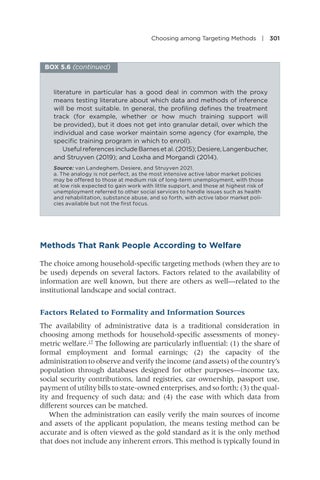Choosing among Targeting Methods | 301
BOX 5.6 (continued)
literature in particular has a good deal in common with the proxy means testing literature about which data and methods of inference will be most suitable. In general, the profiling defines the treatment track (for example, whether or how much training support will be provided), but it does not get into granular detail, over which the individual and case worker maintain some agency (for example, the specific training program in which to enroll). Useful references include Barnes et al. (2015); Desiere, Langenbucher, and Struyven (2019); and Loxha and Morgandi (2014). Source: van Landeghem, Desiere, and Struyven 2021. a. The analogy is not perfect, as the most intensive active labor market policies may be offered to those at medium risk of long-term unemployment, with those at low risk expected to gain work with little support, and those at highest risk of unemployment referred to other social services to handle issues such as health and rehabilitation, substance abuse, and so forth, with active labor market policies available but not the first focus.
Methods That Rank People According to Welfare The choice among household-specific targeting methods (when they are to be used) depends on several factors. Factors related to the availability of information are well known, but there are others as well—related to the institutional landscape and social contract.
Factors Related to Formality and Information Sources The availability of administrative data is a traditional consideration in choosing among methods for household-specific assessments of moneymetric welfare.17 The following are particularly influential: (1) the share of formal employment and formal earnings; (2) the capacity of the administration to observe and verify the income (and assets) of the country’s population through databases designed for other purposes—income tax, social security contributions, land registries, car ownership, passport use, payment of utility bills to state-owned enterprises, and so forth; (3) the quality and frequency of such data; and (4) the ease with which data from different sources can be matched. When the administration can easily verify the main sources of income and assets of the applicant population, the means testing method can be accurate and is often viewed as the gold standard as it is the only method that does not include any inherent errors. This method is typically found in


